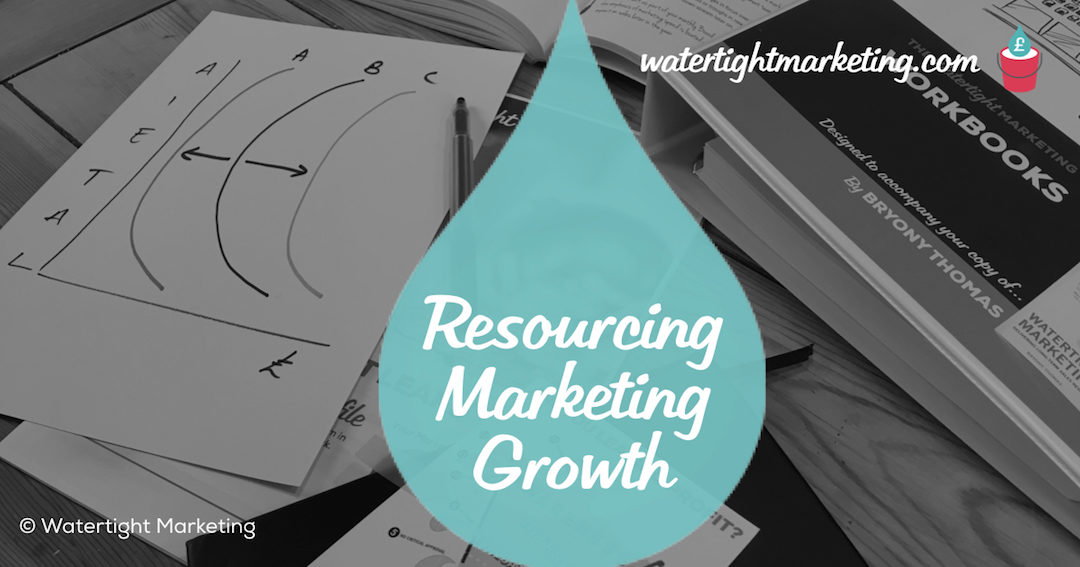One of the things that often seems to present problems for businesses – whatever their size – is resourcing. In larger organisations this manifests itself as questions around objectives, roles and responsibilities, structure and capabilities. In smaller organisations the thinking is more around how to resource a plan and in particular the interplay between time, money and knowledge.
Deciding to outsource marketing is a matter of time, money and knowledge
The three factors which influences how you resource a marketing plan (or indeed any other) are time, money and knowledge, defined as:
- Time: the extent to which you have the time to do something yourself
- Money: the extent to which you have the money to pay for an employee or outsourcing
- Knowledge: the extent to which you know about this area and could do the task yourself
There is another dimension to this model and it is Now versus Future. So, you might not have time or knowledge or money at the moment, but in order to resource things in the future, you might want to gain one, or more, of them.
Insource or outsource?
In thinking about this topic, and how to help businesses make the decision whether to outsource something or do it in-house, I have developed an Insource / Outsource Model:
The more you have of all three factors – time, money, knowledge – the more choice you have. Conversely of course, the less you have of all three (the middle shaded triangle), the more you need to decide either to do it yourself or make some kind of investment in time, money and/or knowledge.
Top and right in the triangle there is a tendency to insource, though you might need to outsource first to (a) gain knowledge before you can then bring it in-house again, or (b) to give you time to gain money to either outsource permanently or recruit and bring the role in-house.
Bottom and left in the triangle there is a tendency to outsource, though at some stage you may decide to employ someone part- or full-time to undertake that task.
How the Insource / Outsource Model helps you to take decisions
Let’s take two different situations so you can see how the model can help you decide. These are both based on real scenarios in real businesses.
A) Know what you want to do and have capacity, but don’t have the marketing skill to do it
Suppose you have a marketing plan but you now need to action it. Imagine that you decide you don’t have sufficient knowledge, at least in certain areas, but you don’t have much money. This puts you at point A on the model.
You have two choices to make:
- Whether to spend the time learning enough about the areas to be able to action those parts of the plan yourself, or
- Whether to invest some money to at least get you set up and making progress, even if you subsequently bring those tasks back in-house.
If you are genuinely committed to taking action, and you really can’t do number 2, then you have to do number 1 (or vice versa). There is always the third option of not doing anything, but if you have already got this far and decided to grow the business in some way and have developed a business and marketing plan to effect this, you’re probably reluctant to take the route of doing nothing.
B) You have neither the time nor the knowledge to execute a marketing plan
The second scenario is where you don’t have the time or the knowledge, but you have some money you could use to outsource a particular task or project (point B), even if it’s only for a while to move things forward.
Longer term, you can do one of three things.
- You can outsource on an on-going basis,
- You can bring the task or project back in-house once you know a bit more, it’s set up or got to a stage where you have a bit more time, or
- You can decide to employ someone, even if part-time, to do this job for you.
But for now, you feel that you can progress things faster and more effectively if you outsource this piece of work. Once that decision has been taken, then you need to develop a brief, find the right supplier and get on with it.
Where do you want to be in the future?
The time-knowledge-money thinking also helps you work out how to resource your business in the future.
Do you want to develop your knowledge so that you can do more in-house? And, if this is true, then what does this say about your time; do you need to relinquish some things to take on a new role?
One client we’re working with is a founder and managing director whose job is currently focused around sales. For several years he has felt he is the best person to go out and sell his particular product but as the business is growing, he needs to spend more time providing direction and leadership as the MD. He has all three – money, time and knowledge (though he does recognise that he needs to develop his leadership skills). His decision for the future is whether to recruit someone who he can trust and to whom he can transfer his current sales role or whether to delegate it to someone already within the company. These are both forms of insourcing, but one will cost more so will depend on whether he wants to make that extra investment of money.
What to do if you have money, knowledge AND time…
Lucky you! If you’re in this position, then you’ll have the luxury of choice about whether to do it yourself in-house or outsource. The factors driving this decision will therefore be more around whether you feel you have sufficient knowledge or time or money to get the job done to the level and quality that you want it done. Sometimes, it can be useful to use external resources for a while. It helps alleviate immediate workload issues and it will develop your team’s knowledge which you can then transfer in-house. Or, it helps buy you time so you can think about what resource you do need, whilst still progressing things.
What to do if you don’t have money, knowledge OR time…
This is, in my experience, the more common scenario for a growing business. You could wait, until you have more of one or more of these things. But, there is only one way out of this position if you want to do something now, and it means taking a decision about investment, in money, time or knowledge. To grow, will sometimes need to make an investment before you can afford it to enable you to ever be able to afford it… Bryony always says, “don’t wait until you’ve lost weight to stop eating pies… you’ll hit your goal faster if you stop eating them now!”
Hopefully, your investment in any of these won’t be so great as to be a deal-breaker. If you can invest enough you are much more likely to get to the next stage faster and more effectively than if you went down the DIY route.
© Bluegreen Learning Ltd

Rachael Wheatley
Managing Director, Watertight Thinking
Rachael brings over 30 years’ of marketing experience, with a particular focus on building and developing effective marketing teams that are able to act as a strategic driving force across an organisation. She has worked with Watertight since 2014 as a Master Practitioner and joined the business as MD in 2022.





Trackbacks/Pingbacks